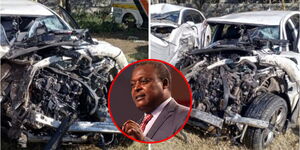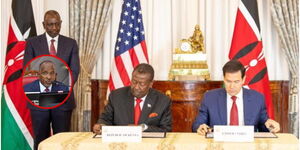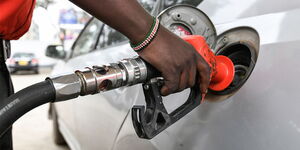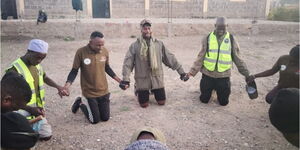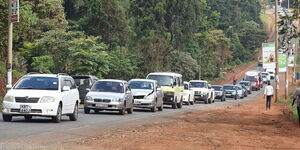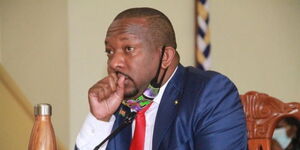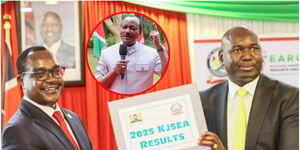President William on Monday, November 7, delivered his inaugural speech at the 2022 United Nations Climate Change Conference in Sharm El-Sheikh, Egypt.
Taking to the podium, he addressed the conference on the impact of climate change in Kenya, Africa and the world, and affirmed his commitment to mitigate the current situation.
Below is his speech:
"Excellencies, Ladies and Gentlemen.
We come together for the 27th annual climate meeting, 30 years after the adoption of the UN Framework Convention on Climate Change in 1992, 25 years since we adopted the Kyoto Protocol in 1997, and 7 years following yet another historic milestone: the Paris Agreement, adopted in 2015.
When the Convention was adopted in 1992, global emissions were approximately 27 gigatons annually. This has risen to about 40 gigatons, while carbon dioxide accumulation in the atmosphere has also steadily increased.
For the past eight consecutive years, documented by the U.N to be the hottest years in recorded history, each new year has been hotter than the previous year. The whole world is reeling from the staggering impact of climate change.
The spread, scale and frequency of disasters like hurricanes, typhoons, wildfires and heat waves, melting sea ice and glaciers, droughts and desertification, floods and rising sea levels, in numerous regions of all continents, indicate that humanity is confronting unprecedented devastation on a global scale.
The State of Climate in Africa report lays it bare. High water stress is estimated to affect about 250 million people in Africa and is expected to displace up to 700 million people by 2030.
In the past 50 years, drought-related hazards have claimed the lives of over half a million people and led) to economic losses of over USD70 billion in the region.
More than 1,000 flood-related disasters were reported involving more than 20,000 deaths in Africa alone over this period. It is estimated that by 2050, climate impacts could cost African nations USD50 billion annually.
The Horn of Africa region, including Kenya, is experiencing the worst drought in 40 years. Two consecutive years without rain have visited misery on millions of people. 2.5 million livestock have died in Kenya this year alone causing economic losses of more than USD1.5 billion.
Two days ago, we went to distribute food relief to 4.3 million affected Kenyans in an emergency programme that has forced us to reallocate funds budgeted for education and health. The trade-offs we are forced to make between indispensable public goods are evidence that climate change is directly threatening our people’s lives, health and future.
Moreover, due to drought, many children have now dropped out of school. We have been compelled to make school feeding a priority in order to keep children in class.
Kenya’s world-famous wildlife heritage has not been spared either, and carcasses of elephants, zebras, wildebeests and many other wild fauna litter our parks. We have had to spend USD3 million to supply feed and water to wildlife in the last 3 months.
.Against this backdrop, the lengthy discussions at COPs, with its stalling, delaying tactics and procrastination that have hampered implementation and delivery, is simply cruel and unjust.
We cannot afford to spend more time skirting around the real issues and we must break out of the open-ended, process-focused discussions we are trapped in. Further delay will make us busy spectators as calamity wipes out lives and livelihoods.
As we speak, the pledge made 13 years ago in Copenhagen, committing USD100 billion annually, remains unfulfilled. Such egregious and unexplained default is a major cause of persisting distrust. Neither is there any sound reason for the continuing pollution.
In stark contrast, Kenya, a country with far less resources than the average developed country, has foregone polluting industrialisation and growth opportunities and intentionally invested in clean, green energy.
It must be recalled that Kenya has tremendous hydrocarbon and coal deposits which would go a long way in fuelling the engines of development. Nevertheless, due to resolute commitment, our electricity grid is 93per cent green.
This morning we signed a framework agreement for collaboration on the development of sustainable green industries in Kenya with an investor to produce 30 GW of green hydrogen in Kenya.
There exist opportunities in Kenya to produce 20 GW of wind power, 10 GW of geothermal electricity and being at the equator, considerable amounts of solar energy.
Green energy production opportunities are vast in Kenya and throughout Africa. In the EAC, for example, there exists sufficient hydroelectric potential to produce 100,000 MW and if properly exploited, could generate enough clean energy for the whole continent.
Instead of struggling to power industrialisation using dirty energy, which is costly and is destroying our planet, we want to make a case for developed economies to decarbonise their production by directing industrial investments to Africa and making use of clean energy to manufacture for the world.
COP26 established the Glasgow Dialogue to formulate funding arrangements for measures to prevent, mitigate and remedy loss and damage associated with the adverse impacts of climate change.
Loss and damage is not an abstract topic of endless dialogue: it is our daily experience and the living nightmare of millions of Kenyans and hundreds of millions of Africans. A phenomenon of rising water levels in the Rift Lakes was experienced in Kenya in 2020 and generated a humanitarian crisis.
Approximately 75,987 households were displaced in thirteen counties with a total population of 379,935 requiring urgent humanitarian assistance.
The affected communities endured disruptions to their livelihoods; losing homes, grazing lands and farming fields while social amenities like schools, health facilities, markets, fish landing and processing facilities, once-thriving hotels, curio shops, resorts and lodges, electricity lines, and water supply and sanitation units, were swallowed by water bodies.
Loss and damage must therefore be addressed with a level of seriousness which demonstrates fairness, urgency and consideration.
Africa contributes less than three per cent of the pollution responsible for climate change but is most severely impacted by the ensuing crisis.
It is therefore only fair and proper that this conference takes necessary measures to recognise Africa’s special needs and circumstances under the Paris Agreement, in line with the convention and relevant decisions adopted by previous COPs.
Beyond the overdue, legitimate and priority concerns of resilience, mitigation, loss and damage, Africa offers unique potential to play an indispensable positive role in the planet’s climate future.
Africa’s vast tracts of land, deep treasures of diverse natural resources, tremendous untapped renewable energy potential, and a youthful, dynamic and skilled workforce constitute the continent's irresistible credentials.
Properly deployed, these assets could be crucial in driving global mitigation efforts while creating new economic opportunities in the continent.
I am convinced of the need to more comprehensively showcase the opportunities that abound in Africa, such as green energy, smart agriculture, de-carbonised manufacturing, e-mobility and green building, all aimed at the attainment of zero carbon by 2050.
As the coordinator of the Committee of African Heads of State and Government on Climate Change (CAHOSCC), I, therefore, plan to convene a continental summit focusing on climate action next year.
Accordingly, you are all invited to take part in Africa’s march to sustainable economic transformation and green growth. Kenya’s next significant export will be carbon credits.
This is why we call for simplified, more transparent carbon market systems that directly benefit communities and not just intermediaries.
Back home, I just launched an ambitious project to increase the national tree cover from the current 12.13 per cent to 30 per cent in the next 10 years. We intend to accomplish this by first growing 15 billion trees on approximately 10.6 million hectares of land throughout the country at an estimated cost of USD5 billion.
In Conclusion, Excellencies, Ladies and Gentlemen in the face of impending catastrophe, whose warning signs are already unbearably disastrous, weak action is unwise; no action is dangerous.
At this point in the progression of this calamity, we have few choices and little time. Our discourse must focus on delivery, and our conversation must be centred on our commitments and implementation.
I call on every delegate here today to rise to the challenge of this moment, to make difficult but necessary decisions and seize transformative opportunity from the grasp of climate disaster.
This means honouring spending commitments for mitigation and adaptation and mobilising increased financial flows to those affected, especially in Africa .
By keeping our promises, and being bound by our word, we will demonstrate to people across the globe that their leaders are their honest agents and true guarantors.
COP, this is our golden chance to vindicate present generations who look to us to lead the way in preserving our planet, and to perform our role as trustees of future generations. The way things are going, we might never have a more opportune time, and there might never be a better chance."

